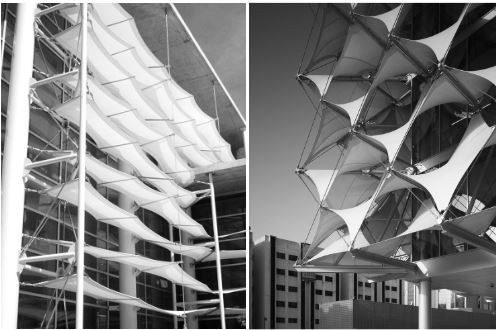Fabric Façade: An Intelligent Skin
Keywords:
Fabric façade, Membrane structures, Textile vertical façadeAbstract
he façade of a building serves various functions. It defines the architectural aesthetics of the building while separates the interior space from the public outside and the another important role is to protect the interior from environmental conditions which is related to energy performance of building. Nowadays, the use of fabric in vertical façade is widely applied to the building due to the advantages of the lightness and environmental efficiency properties. This article aims to review the use of fabric façades in building as intelligent skin. Several recent research works found that textile vertical façades not only provide attractive structures with architectural expression but also environmental efficiency and economically attractive. The presented case studies show the tremendous variety of fabric façade applications which is possibly the new approaches to sustainable building solutions in the future.
Downloads
References
Aksamija, A. (2016). Integrating innovation in architecture: Design, methods and technology for progressive practice and research. John Wiley & Sons Ltd: United Kingdom.
Altomonte, S. (2004). L’involucro architettonico come interfaccia dinamica (The architectural envelope as dynamic interface). ALINEA: Firenze.
Barozzi, M., Lienhard, J., Zanelli, A., & Monticelli, C. (2016).The sustainability of adaptive envelopes: Developments of kinetic architecture. Procedia Engineering, 155, 275-284.
Blum, R, Bögner-Balz, H., & Nemoz, G. (2004). Material properties and testing. In B. Forster, & M. Mollaert (Eds.). (Eds.). European design guide for tensile surface structures. TensiNet: Brussels.
Cremers, J. M. (2015). Fabric structures in architecture: Environmental impact of architectural fabric structures. Woodhead Publishing: Boston, MA.
Dimitriadou, E. A. (2015). Experimental assessment and thermal characterisation of lightweight co-polymer building envelope materials. (Doctor of Philosophy Thesis). University of Bath.
Drew, P. (2008). New tent architecture. Thames & Hudson: New York.
Houtman, R. (2003). There is no material like membrane material. In M. Mollaert et al., (Eds.). Designing tensile architecture. Proceedings of TensiNet Symposium. Vrije Universiteit Brussel: Brussel.
Kolaveric, B., & Parlac, V. (2015). Adaptive, responsive building skins, in building dynamics: Exploring architecture of change. Routledge Taylor & Francis: London & New York.
LeCuyer, A. (2008). ETFE: Technology and design. Birkhäuser Architecture, Basel; Boston.
Mendonça, P. (2005). Living under a second skin – environmental impact reduction strategies of solar passive buildings in temperate climates. (Doctorate Thesis). Civil Engineering Engineering school, University of Minho.
Mendonça, P. (2010). Low-span lightweight membranes in housing – environmental and structural potentialities. Structures and Architecture – Cruz (Ed.). Taylor & Francis Group: London.
Pohl, E. B. (2008). Watercube: The book. Bilingual (Ed.). DRP: Barcelona.
Radwan, A. N., & Osama, N. (2016). Biomimicry, An approach, for energy efficient building skin design. Procedia Environmental Sciences, 34, 178-189.
Robinson, A. L. (2005). Structural opportunities of ETFE (ethylene tetra fluoro ethylene). (Masters Thesis). Massachusetts Institute of Technology, USA.
Salz, C., & Schepers, H. (2006). Arup’s ETFE material note. n.d.: London, UK.
Schmid, G. (2007). Membrane cladded air traffic control tower (Vienna: Job report). In H. Bögner-Balz, & A. Zanelli. Ephemeral architecture: Time and textiles. Milan: Libreria CLUP.
Schiemann, L., & Moritz, K. (2010). Textiles, polymers and composites for buildings: Polymer foils used in construction. Woodhead publishing: UK.
Shaeffer, R. E. (1996). Tensioned fabric structures: A practical introduction. American Society of Civil Engineers: New York.
Tritthardt, J. (1999). Textile fassadensysteme. Perspektiven eines neuen Baukonzepts. Baukultur, 2, 14-19.

Downloads
Published
How to Cite
Issue
Section
License
Copyright (c) 2017 International Journal of Building, Urban, Interior and Landscape Technology (BUILT)

This work is licensed under a Creative Commons Attribution-NonCommercial-NoDerivatives 4.0 International License.











